Atomic Structure and Periodic Table
| Earlier, we’ve studied that elements are the purest substances of all. And each element has its own type of atoms. When scientists first discovered the atom, they believed it was a spherical structure like marbles. Later on other scientists discovered that there the | |
atom is made up of even smaller sub-atomic particles. The Atomic Structure:It was discovered that an atom is made up of three types of sub-atomic particles; these are protons, neutrons and electrons. It was also discovered that in the center of an atom, there is a Nucleus which is made up of protons and neutrons. Around the nucleus there are energy shells in which electrons are. Electrons are always orbiting the nucleus in the energy shells. |
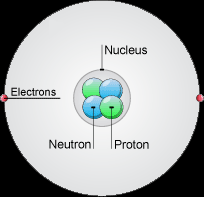 |
Protons and Neutrons are said to be Nucleons because together they make the nucleus. Each type of these sub-atomic particles has its own physical properties which are explained in this table:
Particle |
Symbol |
Mass |
Charge |
Proton |
p |
1 |
+1 |
Neutron |
n |
1 |
no charge |
Electron |
e |
1/200 (Negligible) |
-1 |
These physical properties tell us several factors:
- The mass of the atom is concentrated in the nucleus; this is because the mass of an electron is negligible,
- A neutron has no charge, it is neutral,
- An atom is also neutral; this is because it always contains as much positive protons as negative electrons.
The mass of the sub-atomic particles is in atomic mass unit (AMU). This is because they are so light that they can’t be measured in grams.
There are two numbers given to each type of atoms:
Atomic/Proton Number: it is the number of protons in an atom. And since an atom has an equal number of protons and electrons, it is the number of electrons in the atom too.
Mass/Nucleon Number: it is the number of protons + number of nucleons in the nucleus of an atom. It is called mass number because its value is also mass of the atom.
If the atomic number is the number of protons, and the mass number is the number of protons and neutrons, then subtracting the proton number from the mass number will give you the number of neutrons in the atom.
When we represent the atom of an element, we give it a symbol of one or two letters where the first letter is always in capitals and the second one is in lowercase. The mass number goes above the symbol and the atomic number goes below the symbol.
Example:
4He2
- This represents the Helium Atom,
- Its symbol is He,
- Its mass number is 4,
- Its atomic number is 2,
- It has 2 protons, 2 neutrons (4 - 2 = 2), and 2 electrons.
24Mg12
- This represents the Magnesium Atom,
- Its symbol is Mg,
- Its mass number is 24,
- Its atomic number is 12,
- It has 12 protons, 12 neutrons (24 - 12 = 12), and 12 electrons.
Always remember that:
An atom has an equal number of positive protons and negative electrons which makes it neutral in charge
The Electronic Configuration of Atoms:
Electrons are arranged in energy shells or energy levels. But each energy shell can hold up to a certain amount of electrons.
- 1st energy shell holds up to 2e,
- 2nd energy shell holds up to 8e,
- 3rd energy shell holds up to 18e, but stable with only 8e.
If an atom has its 3rd energy shell holding 8e, if it receives 2 more they go to the 4th energy shell. If further 10e are received, they go to the 3rd energy shell making it saturated with 18e.
Valency electrons are the electrons in the outer most energy shell.
Electronic arrangments in some elements:
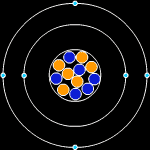 |
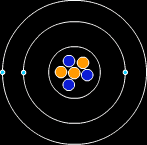 |
| Carbon | Lithium |
The Ion:
During chemical reactions involving two or more atoms, some types of atoms lose one or more electron turning into a positive ion. It is called a positive ion because when it loses electrons, the number of positive protons becomes larger than the number of negative electrons, so the overall charge of the particle is positive. If it loses two electrons its charge will be +2. If it loses 3, its charge will be +3 and so on.
Other types of atoms gain the electrons lost by the positive ions. In this case they become negative ions. This is because the number of negative electrons becomes larger than the number of positive protons, making the overall charge of the ion negative. If it gains two electrons its charge becomes -2. If it gains 3 electrons its charge becomes -3, and so on.
The Isotope:
Some elements have different versions of their atoms. These versions are called isotopes. Isotopes of the same element are similar, only that they have a different number of neutrons. Chlorine for example has two isotopes, Chlorine-35 and Chlorine-37. Isotopes of the same elements do not differ in Behavior or anything, only their masses differ, as a result of having a different number of neutrons.
There are two kinds of isotopes, stable ones and unstable ones. Unstable ones have a lot of neutrons, and they are radioactive. They are called radioisotopes.
Calculating the Relative Atomic Mass (Ar):
The relative atomic mass of an element is the average mass of all its isotopes compared to one-twelfth the mass of an atom of Carbon-12.
The rule of calculating the Ar of an element is:
![]()
M is the mass number
If we have two isotopes of Chlorine; Chlorine-35 and Chlorine 37. The percentage of abundance of these two isotopes in the world is 75% and 25% respectively. We could calculate the Ar by:

The Periodic Table of Elements:
The periodic table is a table containing all elements arranged in ascending order from the one with lowest atomic number to the one with highest atomic number.
There are there are 8 vertical groups (Columns) in the periodic table. The group number is equal to the number of electrons in the outer most energy shell of the atoms of the elements in the group. This is why elements of the same group share the same chemical properties.
There are seven horizontal periods (rows) in the periodic table. The period number is also the number of occupied energy shells in the atoms of the elements in the period.
So if an element has 3 valence electrons, it will be in group 3. And if it has 4 occupied energy shells, it will be in period 4.
We have two types of elements in the periodic table. These are Metals and Non-metals. As we move in the periodic table from the left to the right, the metallic properties of elements decrease. Metals include Magnesium, Calcium, and Sodium. Non-metals include Carbon, Oxygen and Chlorine. All metals are solid. All non-metals are either solid or gas, except for bromine which is liquid.
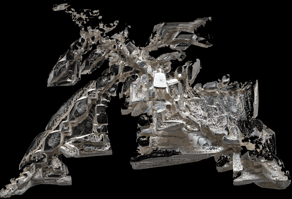 |
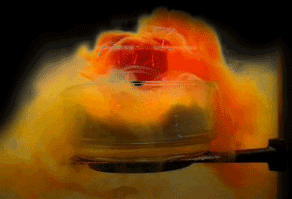 |
|
| Silver appears as a lustrous white metal | Bromine is a non-metal |
Metals and non-metals have different Physical properties:
| Physical Property: | Metals | Non-Metals |
|---|---|---|
| State In Room Temperature | Solid (Except Mercury, Liquid) | Solid-Gas (Except Bromine, Liquid) |
| Density | Very Dense (Except Group 1) | Low Density |
| Appearance | Shiny, Most Are Grey Except Copper And Gold | Most Are Dull (Except Diamond |
| Melting Point | High (Except Groups 1 & 2) | Low (Except Diamond-Graphite) |
| Boiling Point | High (Except Groups 1 & 2) | Low (Except Diamond-Graphite) |
| Malleability | Hard And Malleable | Soft And Brittle |
| Ductility | Ductile | Not Ductile |
| Electrical Conductivity | Conductors | Poor Conductors (Except Graphite-Silicon) |
| Heat Conductivity | Good | Very Poor |
| Sonority | Sonorous | Non-Sonorous |
Malleability: If a metal is malleable it means it can be hammered into shapes without being broken.
Ductility: If a metal is Ductile it means it can be pulled into wires.
Sonority: If a metal is sonorous, it means it makes a pleasant sound when struck.
Metals and non-metals also differ in chemical properties:
| Metals | Non-Metals |
|---|---|
| They have either 1,2 or 3 valence electrons | They have either 4,5,6,7 or 8 valence electrons. Except helium which has 2. |
| They lose electrons forming positive ions | They gain electrons forming negative ions |
| They are reducing agents | They are oxidizing agents |
| They form basic or amphoteric compounds | They form acidic or neutral compounds |
| Forms ionic compounds with non-metals | Form either ionic compounds with metals, or covalent compounds with other non-metals |
Special Elements:
Alkali Metals:
These elements lie in group 1 of the periodic table. They are Lithium, Sodium, Potassium, Rubidium, Caesium and Francium (radioactive). We will study the properties of the first three; Lithium, Sodium and Potassium. Like any metals they are all good conductors of heat and electricity. They are however, soft. Lithium is the hardest of them and potassium is the softest. They are extremely reactive; they have to be stored away from any air or water. They have low densities and melting points.
They react with oxygen or air forming a metal oxide:
| 4Li | + | O2 | → | 2Li2O |
| (Lithium) | (Oxygen) | (Lithium Oxide) |
Their oxides can dissolve in water forming an alkaline solution of the metal hydroxide:
| Li2O | + | H2O | → | 2LiOH |
| (Lithium Oxide) | (Water) | (Lithium Hydroxide) |
They react with water vigorously forming metal hydroxide and hydrogen gas:
| 2K | + | 2H2O | → | 2KOH | + | H2 |
| (Potassium) | (Water) | (Potassium Hydroxide) | (Hydrogen) |
They React with Halogens forming a metal halide:
| 2Na | + | Cl2 | → | 2NaCl |
| (Sodium) | (Chlorine) | (Sodium Chloride) |
For this group, the further you go down the more reactive the metals become, this is the most reactive group.
The Halogens:
These are elements of group 7; Fluorine, Chlorine, Bromine, Iodine and Astatine.
We will study only properties of chlorine, bromine & iodine. They are colored and the color gets darker as we go down the group. They exist as diatomic molecules (Cl2, Br2, I2). As you go down, they gradually change from gas to solid (chlorine is gas, bromine is liquid and iodine is solid).
They react with hydrogen forming hydrogen halide, which is an acid if dissolved in water:
| H2 | + | Cl2 | → | 2HCl |
| (Hydrogen) | (Chlorine) | (Hydrochloric Acid) |
They react with metals forming metal halide:
| 2Fe | + | 3Cl2 | → | 2FeCl3 |
| (Iron) | (Chlorine) | (Iron Chloride) |
The reactivity also decreases as we do down, chlorine is most reactive, followed by bromine then iodine.
If you bubble chlorine gas through a solution of potassium bromide, chlorine will take bromine’s place because it more reactive. This is a displacement reaction.
| 2KBr | + | Cl2 | → | 2KCl | + | Br2 |
| (Potassium Bromide) | (Chlorine) | (Potassium Chloride) | (Bromine) |
Transition Elements:
These are metals. They form a big part of the periodic table. Some of them are very common like copper, zinc and iron. They have the following properties:
- They are harder and stronger than metals of groups 1 & 2.
- They have much higher densities than metals other metals.
- They have high melting points except for mercury.
- They are less reactive than metals of group 1 & 2.
- Excellent conductors of heat and electricity.
- They show catalytic activity (act as catalysts)
- They react slowly with oxygen and water
- They form simple ions with several oxidation states and complicated ions with high oxidation states.
Noble Gases:
These are elements in group 8 of the periodic table. They are colorless gases. They are extremely unreactive; this is because they have their outer energy shell full with electrons. So they are stable, this is why they exist as single atoms. They have some uses however, for example argon is used in light bulbs to prevent the tungsten filament from reacting with air, making the bulb last longer. Neon is also used in the advertising and laser beams. These gases are Helium, Neon, Argon, Krypton, Xenon and Radon (radioactive).